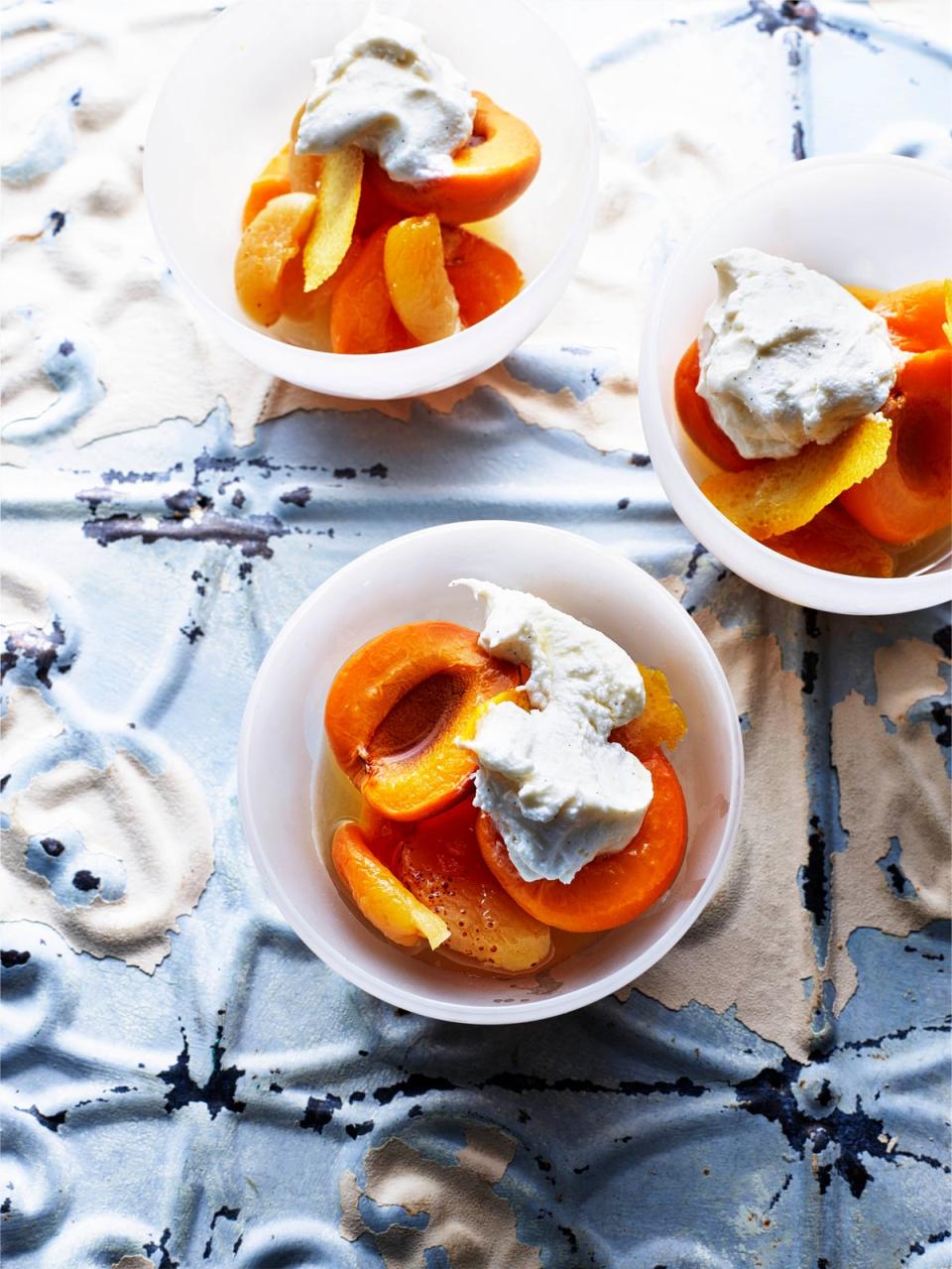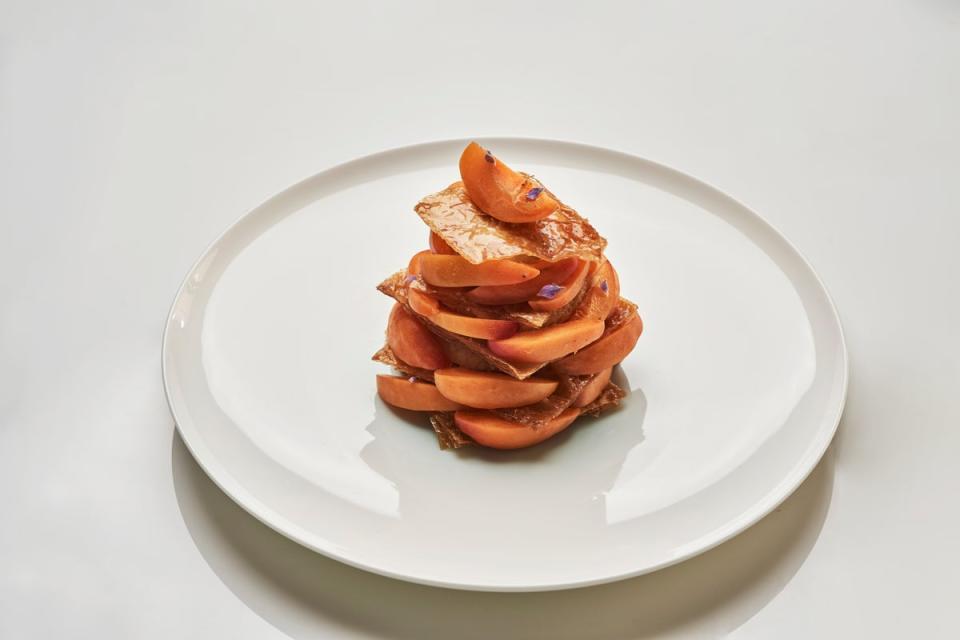Everything you need to know about apricots

Britain is seeing more home grown apricots than ever before, and earlier than ever before, thanks to a winning combination of wind and rain this year, as well as the recent heatwave.
First introduced to the UK around 2005, commerical production didn’t really pick up until 2012, when around 40 tons were harvested. This year, a whopping 250 tons are expected to hit supermarket shelves, and could last until around mid-September. That means the UK will probably be one of the only countries in the world where apricots are still being available at that time of year.
But what is the tastiest variety, how can you tell when an apricot is perfectly ripe, and how do you grow them at home? We asked the experts.
“The variety to look out for intially is Mediva – they are gloriously good,” David Josephs, owner of Panzer’s Deli in St Johns Wood, tells The Independent. Later in the month, you can expect the Faralia, Fartoli and Farbela varieties. Judging whether an English apricot is ripe and ready to eat will depend on a few factors, he says. “The skin should be 50 per cent red blush and 50 per cent orange hue,” he says. “The smell will have a citrus, sweet, acid smell. If they don’t have this, then their sugars are not developed enough.” The apricot should also be dense and firm, but never crunchy!
Of course, you can’t beat an apricot fresh off the tree, but Jospehs adds: “I love making a simple salad of tomato, oven-roasted apricots, mozzarella and fresh basil, with a few drops of 12-year-old balsamic vinegar.”
Robin Gill, chef-owner of the newly opened Bottle & Rye, a Parisian-style wine bar in Brixton, thinks apricots for breakfast is a great start to the day. “I serve them so simply, just slice them into wedges and place in a bowl with fresh ricotta, toasted walnuts and honey. Heaven!”
To avoid wasting any part of the apricot, he recommends keeping the stones in a jar filled with vinegar to use later. “The stones give off an almond flavour, which is great with a nice, fatty piece of pork belly,” he says.
Growing them at home is easier than you might think, too. Catherine Butters, head gardener at Moor Hall in Lancashire – which was voted the best restaurant in England at this year’s National Restaurant Awards – has been growing them in their garden since day one. “They are one of my favourite fruits to grow,” she tells The Independent. While the majority of the UK’s apricots are grown in the warmer climes of Kent, Butters has some trees growing in a glasshouse, as well as some outdoors planted straight into the ground and up against a brick wall, “which is a great trick to keeping your apricot tree healthy as the bricks retain heat for a long time,” she says.
If you want to start growing your own apricots, Butters has some essential tips: “Plant your trees and let the blossom start to come through. At this point, you’ll need to hand pollinate the tree by tickling the blossom with a dry paint brush. Then let the leaves and branches grow until you start to see the fruit forming. At this point, prune the tree a little to allow more light in to ripen the fruit, enabling the apricots to receive all the nutrients they need and in about 3-4 weeks they’ll be ready to harvest.
“If growing your apricot trees in a glasshsouse, water for around half an hour once a week during the colder months, but then in summer gradually reduce the watering to prevent the fruit from splittings,” she adds.
If you’re successful, you’ll have barrel loads of apricots which can use in the recipes below, shared with us by some of the country’s top chefs.
Poached apricots, orange flower water, whipped mascarpone

By: Ben Tish, chef director, Cubitt House
The origin of the apricot is shrouded in mystery and uncertainty. It is said by some to have originated in Armenia and others say that its beginnings lay in the far east. However, we do know that they’ve been cultivated in Persia since antiquity and from there have made their way around Europe and grow particularly well in Spain and southern parts of Italy.
Apricots were (and still are) an important fruit in Arabic and Moorish cuisine. Apart from being delicious and versatile when fresh and in season, they also dry and preserve very well. Important for shelf life but dried apricots are another thing all together from their fresh counterparts – they have an intense sweet and sour flavour from the dehydrating process and are brilliant added to tagines and sauces for depth of flavour.
There’s also much evidence that these dried orange fruits have many medical benefits, including helping with digestion and skin conditions.
I’ve used both fresh and dried in this recipe as I feel the textures contrast well together.
Serves: 4
Ingredients:
6 fresh apricots, cut in half and stone removed
6 dried apricots (an organic variety is best as they don’t include preservatives)
5 drops orange flower water
Peeled zest of ½ orange
75g golden caster sugar
100ml full fat mascarpone
½ vanilla pod- seeds scraped out
Method:
Place 50g sugar and 150ml water in a saucepan with the orange zest and bring to a slow boil.
Add the dried apricots, cook for 3 minutes and then add the fresh apricot halves.
Continue to cook for 10 minutes until the fruits are nice and tender and the liquid has turned syrupy.
Turn off the heat. Add the flower water and leave to macerate for at least 1 hour at room temperature.
Vigorously whisk the mascarpone with the remaining sugar and vanilla until fully incorporated.
Serve the poached apricots and some syrup with a dollop of mascarpone. Also delicious with my almond and caramel ice cream.
Apricot Greek milk pie

By: Asimakis Chaniotis, executive chef, Pied à Terre
This is my refined take on a classic Greek milk pie. I created it last summer when I was in Greece back at my family home on the island of Kefalonia where we have apricot trees in the garden. I had fun experimenting with the harvest and made lots of apricot “membrillo” to go with our cheese course at the restaurant along with this creation. The dessert is simple to make but has a wow-factor – give it a go!
Serves: 3-4
Ingredients:
6 filo pastry sheets 7cm by 7 cm
6 filo pastry sheets 6cm by 6 cm
6 filo pastry sheets 5cm by 5 cm
6 filo pastry sheets 4cm by 4 cm
3 tbsp melted butter
3 fresh and ripe apricots - cut in half, stones removed and then cut into wedges about 1cm thick
For the cream filling:
300ml milk
130g sugar
60g fine semolina
2 whole eggs
1 tbsp butter
1/5 vanilla pod (seeded scraped) or 2 drops of vanilla essence
For the lavender syrup:
50ml water
50g sugar
1 tsp lemon juice
2 sprigs of lavender
Method:
Preheat your oven to 180°C
Start with the filo pastry which you have already cut into different sized squares. Butter each piece and stack each same-sized piece together so you have 6 piles, all different sizes. This will create an impressive tower shape when you serve your dessert.
Place the filo piles onto a baking tray, lined with greaseproof paper, and bake for 15 minutes until golden brown
Meanwhile make your lavender syrup by adding all of the ingredients into a pan and bringing to a boil, before taking off the heat. Remove the sprigs of lavender.
Over a wire rack, pour the hot syrup over the hot cooked filo pastry and leave to cool until the pastry dries out and is crispy.
Bring the milk to the boil and add the semolina, whisk constantly until it boils and thickens.
In a separate bowl, whisk the eggs with the sugar and the vanilla. Take the milk mix off the heat and allow to cool slightly. When still warm, but not scorching, slowly start adding the milk mixtures to your bowl whilst whisking constantly. Add the butter and mix until it’s all emulsified.
Leave the mixture to cool down but mix it every 5 minutes so it will not have a crust on top, then cover with clingfilm and place in the fridge for around an hour to set completely.
When set, remove from the fridge and whisk for a minute before transferring to a piping bag.
To serve, place the biggest piece of filo onto a serving dish. Pipe on a circle of cream, leaving space around the edge. Repeat until you’ve finished up all of the filo and you have a tower shape. Place the wedges of apricot into the layers of filo and cream. Serve immediately.
Apricot tart with almond and hazelnut crust

By: Lucy Carr-Ellison and Jemima Jones, co-founders, Wild by Tart
Ingredients:
150g chocolate hobnobs
100g almonds, toasted
100g hazelnuts, toasted
150g butter
1 tsp sea salt
500g apricots, quartered
50g butter, cut into small cubes
1 tbsp demerara sugar
Bunch of thyme
½ glass of masala or white wine
200g mascarpone
200g yoghurt
1 tsp vanilla extra
150g lemon curd
Zest of 1 lemon
150g honey
Thyme
Juice of ½ lemon
Method:
Whiz the hobnobs in a food processor (or bash in a bag) to a fine crumb and place in a bowl. Roughly chop the nuts and add to the hobnobs. Place the butter in a small pan and melt then add to the nut mixture with the salt and combine.
Tip the mixture into the tart case and push to create a tart shell, spread evenly and place in the fridge to harden.
Heat the oven to 190c.
Half the apricots and destone, place on a baking tray, drizzle with the wine and sugar, sprinkle over the thyme and dot over the butter. Place in the oven and cook for 15 minutes. Take out and cool.
Mix together the mascarpone, yoghurt, vanilla, lemon curd and lemon juice – combine and leave to one side.
Place the honey and the thyme in a small pan and bring to a simmer then take off the heat and add the lemon juice.
Take the crust out of the fridge dollop in the mascarpone mixture and spread evenly. Place the apricots over the top then take a pastry brush and brush over the honey mixture. Either eat straight away or place back in the fridge till needed but serve within 24 hours.
Tip: To take the tart out of its tin place on top of a can of beans take a cloth and dip into hot water and run around the tin case – repeat until the case comes loose.

 Yahoo News
Yahoo News 